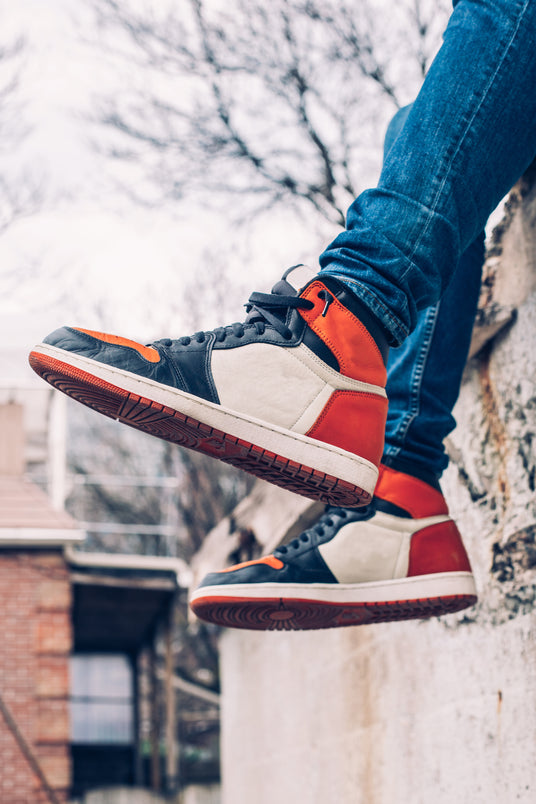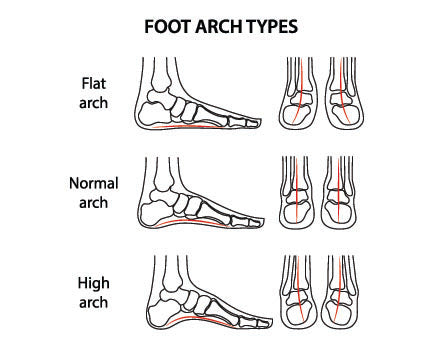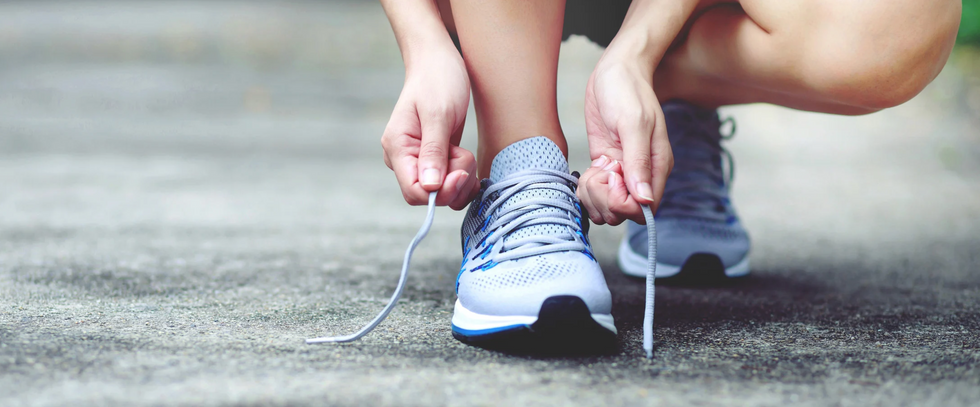Insole Guide: How to Choose the Right Insoles
There’s something special about a new pair of shoes.
The new leather smell when you open the box. How smooth and sleek they look without scuffs or wear. The bouncy feeling you get when first putting them on before the insoles have molded to your feet. Whether you’re buying a new pair of shoes for the next road race or a day at the office, they might be missing something important: proper support.
Chances are, your shoes don’t come with the most supportive insoles – or any supportive insoles, for that matter. You can easily add support to almost any pair of shoes (even Converse), by purchasing a pair of insoles.
Shoe insoles are not only for those suffering from foot ailments or disorders. While your new pair of shoes may look great on your feet, they may not be the best thing for your feet in the long term, and that is where insoles come into play.
What Are Insoles?
Insoles are pieces of padded material that are placed inside your shoes or boots for extra comfort, warmth, and a better fit.
Sometimes referred to as “foot beds”, insoles are designed to add support to shoes as well as make them more comfortable to wear. Insoles do take up room in the shoe, even when removing the existing insoles (which are usually shoe liners) that come with your shoe, so it’s important to select insoles that are made with your specific shoes in mind.
We’ve curated dozens of insoles for every type of shoe, from high heels to running shoes, here.
Are Insoles The Same As Orthotics?
The words ‘insole’ and ‘orthotic’ are often used interchangeably; however, they are not the same.
Orthotics are similar to insoles in that they provide cushioning, padding, and support to your shoes; however, they differ in that they are custom-made for your foot shape, whereas insoles are more generalized and not an exact custom fit. Both insoles and orthotics can cushion against shock, protect your feet, and also provide extra support in your shoes. And for many people, insoles are just as effective as orthotics.
Common Reasons To Buy Insoles
Insoles do more than take up space in your shoes. Insoles can be used for the following purposes:
- Relieve pain
- Improve athletic performance
- Provide support
- Add comfort
Let’s look at some of the ways that the insoles at Insoles.com can help with the above!
How Insoles Relieve Pain
Insoles can help relieve pain from an existing condition or provide support to your shoes in order to prevent a condition from worsening or even happening in the first place. As always, if you are experiencing pain, you should consult your doctor before trying any treatments. Below are some of the top conditions we have seen across our customers as reasons for buying insoles:
- Plantar fasciitis
- Morton’s Neuroma
- Metatarsalgia/ball of foot pain
- Back pain
- Knee pain
- Shin splints
- Gout
We’ll explore each of these conditions next to show how insoles can help with them.
Insoles Help With Plantar Fasciitis & Arch Pain
Plantar Fasciitis is the most common cause of heel pain. The plantar fascia is a thick band of tissue that supports the arch of your foot and connects your heel bone to your toes. If you strain this tissue, it can become swollen and inflamed, causing pain in your heel and throughout your entire arch when you stand or walk. Learn more about plantar fasciitis.
Insoles Help With Morton's Neuroma
Morton’s neuroma is pain, numbness, or tingling in the forefoot, especially between the 3rd and 4th toes. The pain is due to the thickening of the nerve that supplies the sensation to the area between the toes. Other names for the condition are Morton’s metatarsalgia, Morton’s neuralgia, plantar neuroma, and intermetatarsal neuroma. Learn more about Morton’s neuroma.
Insoles Help With Metatarsalgia & Ball-of-Foot Pain
Metatarsalgia (also called ball of foot pain) is a broad term, and there may be a more specific term that can be used for the specific condition. You may experience aching or burning beneath the ball of the foot, and you may feel as if you have a pebble in your shoe. The discomfort is often made worse with standing or walking activities. Learn more about ball of foot pain.
Insoles Help With Back Pain
Nearly everyone experiences back pain during their life. Back pain can be aching or throbbing, or pinching, and the intensity can range from mild to severe. There are a variety of causes for back pain, and poor support for your feet could be one of them. Learn more about back pain.
Insoles Help With Knee Pain
There are a variety of causes for knee pain, such as arthritis, cartilage tears, and tendonitis. If you are experiencing knee pain, another factor that is good to keep under consideration is how you are walking. This is the kind of knee pain that stems from your feet and arches. Learn more about knee pain.
Insoles Help With Shin Splints
Have a throbbing or aching in your shins after running, or even after just a short sprint? You may be experiencing shin splints. Shin splints are a common condition for those who frequently participate in strenuous physical activity, especially stop-and-start sports. Learn more about shin splints.
Gout
Gout is a painful inflammation of the joints, most commonly isolated to the joint at the base of the big toe. This type of arthritis is severely painful and causes great discomfort while walking. Someone with this condition will experience extreme tenderness along the joint line as well as skin warmth and swelling. Learn more about gout.
How Insoles Improve Athletic Performance
Insoles don’t just relieve pain; they can also prevent conditions from occurring in the first place and provide a necessary boost to athletic performance. In our shop, we sell a variety of insoles specifically designed for sports and other athletic activities, such as:

Insoles can be a great help in relieving pain from a variety of conditions.
How Insoles Provide Support
Insoles can provide added support to your shoes to reduce your risk of injury as well as prevent injuries from worsening. From overpronation to arthritis, there are many ways insoles can provide support to your shoes and keep you on your feet.
Insoles can provide necessary support for:
- Overpronation
- Arthritis
- Diabetic foot
Let’s explore each of these conditions in more detail to show how insoles can provide additional support.
Insoles Provide Support for Overpronation
People with low or flexible arches, however, may be at risk of overpronation - a condition when the arches of the foot roll inward/downward more than normal when walking. Pronation is a natural movement of the foot; however, if your ankle rolls too much, you are over-pronating and at risk of injuries to the foot or ankle. Learn more about overpronation.
Insoles Provide Support for Arthritis
Different types of arthritis commonly affect the foot or ankle, including osteoarthritis, rheumatoid arthritis, and gout. Arthritic pain can range from mild to severe. Each type of arthritis can cause different symptoms, but in all of them, inflammation is a factor. Learn more about arthritis.
Insoles Provide Support for Diabetic Foot
When you have diabetes, you are more susceptible to developing foot problems. Even ordinary problems can get worse and lead to serious complications. These include neuropathy, peripheral vascular disease, calluses, foot ulcers, and poor circulation. If these conditions are not properly treated, they can lead to serious complications, and at times, they can lead to amputation. Learn more about diabetes.

Insoles can provide support for a variety of conditions and activities.
Types Of Insoles
Between high-heels and Converse, baseball and golf, you can imagine that no two pairs of insoles are the same – and you’d be correct!
There are different types of insoles to choose from:
- Orthotic arch supports
- Cushioned arch supports
- Flat cushions
- Athletic/sport insoles
- Heavy-duty insoles
- High-heel insoles
Orthotic Arch Supports
Orthotic arch supports are insoles that feature a rigid or semi-rigid support plate or support platform. Also called ‘orthotic insoles’, ‘arch supports’, or ‘orthotics’, these insoles help ensure your foot maintains a natural and healthy shape throughout the day.
Orthotics support your foot by focusing on the main areas of the foot: the arch and the heel. Orthotics are designed with built-in arch support to prevent the collapse of the arch as well as a heel cup to stabilize your ankle. Orthotics are a great option for preventing plantar fasciitis or arch pain. Additionally, they ensure natural foot movement as you walk, which can prevent over-pronation or supination.
Cushioned Arch Supports
While orthotics provide rigid or semi-rigid arch support, cushioned arch supports provide flexible arch support made from padded cushioning in your shoes.
Cushioned arch supports may also be called "arch cushions." These insoles are designed to provide some support for the foot while focusing primarily on providing maximum cushioning. This is particularly useful in situations where proper support is desired, but the primary goal of the insole is to provide relief from foot fatigue. Walkers/runners seeking cushioned support tend to prefer cushioned arch supports over orthotic arch supports, and people who spend all day standing but otherwise suffer from no foot conditions benefit most from cushioned arch supports.
Flat Cushions
Flat cushioning insoles provide no arch support at all; however, they are still very useful in that they provide a cushioning liner for any shoe. These insoles are not designed to provide support; rather, they can be placed in a shoe as a replacement liner or to add a bit of extra cushioning for your feet.
Athletic/Sport Insoles
Athletic or sports insoles are often more specialized and technical than standard insoles, which makes sense, they are engineered for optimal performance. Athletic insoles are designed with specific functions or sports in mind.
For example, runners typically require good heel & forefoot padding as well as a foot support system to assist with their heel-to-toe (gait) movement. Cyclists require more arch support and support on the forefoot. And those who partake in snow sports like skiing or snowboarding will need warm insoles that retain heat and cushion their boots. Check out our full list of insoles by activity.
Heavy Duty Insoles
For those who work in construction, service work, or are on their feet all day and need some extra support, heavy-duty insoles may be required to provide the support you need. Heavy-duty insoles are designed to add reinforced cushioning and support. Browse our insoles for work to find a pair that is right for you.
High Heel Insoles
Heels may be stylish, but they can also be painful (and put you at risk of foot injury). As a result, adding slender, low-profile insoles can add support to keep you on your feet and prevent injury when wearing heels. We carry a number of high-heeled insoles, including the Superfeet Easyfit high heel.

There's an insole for every shoe, activity, condition, or arch type.
Whatever you are looking for or need, chances are there's an insole perfectly suited for you. Choose wisely, and put your best foot forward.
Half vs Full-Size Insoles
Not only do insoles come in a variety of materials, but you can also buy half-size insoles or full-size insoles!
Beyond size, there is a key difference between these that you should be aware of. Full-length insoles provide a little extra cushioning in the forefoot. These may be high volume (they take up a lot of space and usually have more cushion) or low volume (they take up minimal space with a minimal amount of cushion). Full-length insoles tend to be used in place of the removable liner that comes with most shoes to provide better (or more specific) support.
Meanwhile, half insoles (also called short insoles or three-quarter insoles) are designed to fit in shoes that do not have a removable insert. This allows you to add support to shoes that otherwise would not allow you to add an insole to them. Typically, this would be dress shoes, flats, boat shoes, or high heels. These also work well in winter boots and fashion boots.
What To Look For When Buying Insoles
Suddenly, those thin inserts at the bottom of your shoes are looking a lot more sophisticated. Don’t worry, we’ve got a simple checklist to keep in mind when evaluating different insoles and choosing the right insole for you.
We recommend you choose with the following in mind:
- Your activity
- Size
- Placement in the shoe
- Arch type
- Footbed type
- Material
Let’s walk through each of these criteria next.
Insoles For The Right Activity
Choose different insoles for high-impact activity and low-impact activity. Insoles designed for hiking may not be the same as those optimized for soccer. There are two reasons for this: specifically designed shoes for activities will vary, as will the type of support you need during that activity.
It’s important to consider the activity when choosing insoles - are you getting a pair for your favorite hiking boots or your heels? Do you need an insole for standing all day or for running? You can browse our full list of activities to help narrow down your choices.
Insoles That Are Properly Sized
The size of the insole is obviously pretty important - they need to fit in your shoes after all. Insoles are typically sized by a range of shoe sizes (for example, Men’s 9-11). For most insoles, this is because they are designed to be trimmed down to fit your shoe perfectly. If you know your foot measurements, then pick the insole that corresponds to your foot size. If you do not know your foot measurement, then pick the insole that corresponds to the size of the specific shoe you want to put it in.
For 3/4-length insoles and other insert pieces, the size range on the product denotes the footwear sizes in which the insoles/inserts can be comfortably used; 3/4-length insoles and inserts are usually not designed to be trimmed in any way. If you are between sizes (you wear a size 9.5 when the insoles are sized "8-9" and "10-11"), you should generally buy the size down.
Read our full insole size guide for more information.
Insole Placement
Almost all full-length insoles are designed to completely replace the liner that comes with your shoe; only very thin insoles can be added to a shoe without removing the insole that comes with it. ¾ length insoles, on the other hand, are intended to be placed inside a shoe without removing the liner that comes with it.
Insoles For The Right Arch Type
This one is key - you should match your insoles to your arch types, otherwise you risk painful arches and potential injury. If you are not familiar with your arch type, we have a guide on how to tell if you have flat feet as well as a guide on high arches. Arches usually fall into three buckets:
- Neutral/medium arches
- Low arches/flat feet/fallen arches
- High arches
When browsing insoles, take note of the arch types they are suited for and make sure you are purchasing an insole made for your arch type.

Be mindful of your arch type when choosing insoles to ensure you choose the right insole for your foot.
Footbed Type
Insoles and orthotic arch supports typically have one of four different footbed constructions:
- Rigid orthotic arch support
- Semi-rigid orthotic arch support
- Cushioned arch support
- No arch support/flat cushion
The type of footbed that you need will be heavily dependent on why you are looking for an insole, and you should be sure that you browse products with a footbed type that will suit your needs.
Insole Material
Lastly, you need to consider the material. As discussed above, insoles come in a variety of materials:
- Foam: Memory foam isn’t just for your mattress - memory foam’s incredible softness and ability to retain shapes make it a perfect material for insoles. Memory foam insoles are great for folks looking to add a soft, plush layer to their shoes.
- Gel: Gel insoles provide targeted cushioning and pressure relief, especially in high-impact areas like the heel and forefoot. The gel material absorbs shock effectively and can help reduce foot fatigue, making these insoles popular among athletes and people with foot pain or plantar fasciitis.
- Cork: Cork insoles offer natural antimicrobial properties and excellent moisture-wicking capabilities. This eco-friendly material molds to your foot shape over time, providing personalized support while remaining lightweight and breathable. Cork insoles are perfect for those seeking sustainable comfort.
- Leather: Leather insoles provide a classic, breathable option that improves with age. They offer moderate cushioning while allowing air circulation, helping to reduce moisture and odors. Leather insoles are ideal for dress shoes and formal footwear where you want comfort without bulk.
- Wool: Wool insoles may be the perfect addition to your boots to provide support and warmth through any winter sport. Not only do wool insoles provide support to any shoe, but they also help regulate and maintain the temperature of your feet, whether in the hot or cold. Check out our Superfeet wool insoles to add insulation and comfort to your shoes in any season.
- Plastazote: This closed-cell foam material is highly customizable and often used in medical and orthotic applications. Plastazote insoles can be easily modified by healthcare professionals and provide excellent pressure distribution, making them ideal for people with diabetes, arthritis, or other foot conditions requiring specialized support.
- EVA: Ethylene Vinyl Acetate (EVA) foam insoles are lightweight, flexible, and offer excellent shock absorption. These durable insoles resist compression and provide consistent cushioning over time, making them a popular choice for athletic shoes and casual footwear.
- Heat moldable: By heating these insoles for a short time in the oven and then standing on the insoles while they cool, you are able to mold the insoles to your unique foot shape instantly. Browse our selection of Form heat moldable insoles to find the perfect insert for you.
Each material has its advantages, but what it really comes down to is personal preference. Foam and gel are usually the best for cushioning and shock absorption, while cork or rigid/semi-rigid plastic is usually best for support. Beyond that, go with what feels best and provide the support you need for your shoes.
How Long Do Insoles Last For?
How long your insoles or orthotics last will vary based on the brand, usage, and material of the insole. Your weight and gait will also play into how long your insoles will last.
The higher the quality of your insoles, the longer they are likely to last. Still, there are some variations, usually based on the materials your insoles are made out of. Softer insoles, even when high quality, will tend to wear out faster than firm insoles.
We generally recommend replacing your insoles every 6-12 months. Most of our customers replace their insoles every 6-8 months to ensure they are as supportive as possible. Your mileage will vary.
How To Know When It Is Time To Replace Your Insoles
While every person and insole is different, here are a few signs that it may be time to replace your pair of insoles.
- Wearing and fading: If your insoles have a clearly worn spot or are starting to get a bit tattered, then it may be time to replace them. It’s not about appearances; it’s about ensuring they are providing adequate support for your feet.
- Flattening/loss of comfort: If your insoles are not providing the same level of comfort or support that they used to, it may be time to replace them.
- Tearing or splitting: Eventually, your insoles might be worn to the point of being torn or split. If that’s the case, then it is time to replace them.
- Weakened or flattened arch support or metatarsal pad: After many miles of wear, the amount of support may become compromised. If your insoles do not feel as supportive as they did when you first started wearing them, it is time for a replacement.
For some users and insoles, this might take 6 months, while others may be able to wear the same pair of insoles for a year or more. Make sure to pay attention to how your insoles look and how well they are supporting your feet in order to make a decision. For a deeper dive into this, check out our guide to knowing when it’s time to replace your insoles!
If you find your favorite pair of insoles is a bit worse for wear, browse for a replacement in our shop!
How To Choose The Right Insoles For You
As you can see, there is quite a bit to choosing the right insole for you. If you need help determining which insole may work the best for your specific needs, then try our Insole Advisor for a recommendation.
As a rule, start with the activity or type of foot pain, along with the shoe type you need an insole for. Narrow things down by your arch type and personal preference for materials. Insoles are a fantastic way to add support and cushioning to your shoes, as well as prevent or even help treat injury. With free shipping on all orders, you can purchase insoles easily to try on at home and find the perfect pair of insoles for you.

